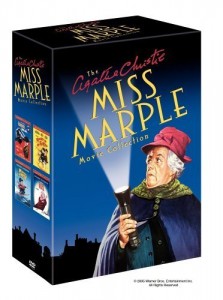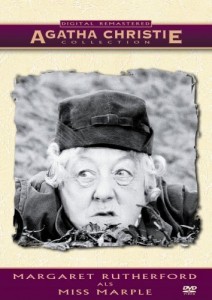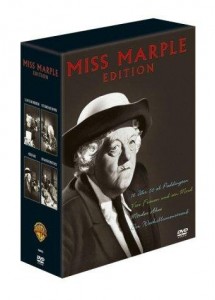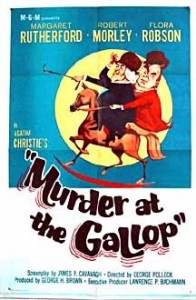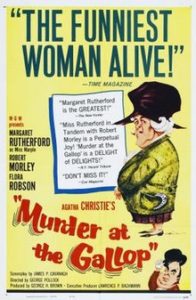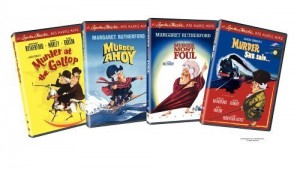Murder at the Gallop **** (1963, Margaret Rutherford, Stringer Davis, Robert Morley, Flora Robson, Finlay Currie, Charles Tingwell) – Classic Movie Review 865
Hooray for Margaret Rutherford’s second, exceedingly satisfying big-screen mystery entertainment as Dame Agatha Christie’s sleuth Miss Marple, the 1963 comedy crime thriller Murder at the Gallop.
Old Lady Crime snoops to conquer when the rich recluse Old Mr Enderby (Finlay Currie) is supposedly terrified to death by his cat. It’s a heart attack, but, understandably, Miss Marple suspects any one of his four poor relatives, all heirs to his estate, of his murder.
So she heads for The Gallop, a combined boarding house and riding school, where Old Enderby’s relatives have gathered. And then his sister is killed too…
Rutherford’s Miss Marple of course has no trouble whatever in smoothly solving the two murders, turning down a proposal of marriage, and seeing off rival spotlight-seeking actors in Robert Morley as young Hector Enderby, Currie’s nephew, and Flora Robson as Miss Gilchrist, Currie’s sister’s friend.
Co-starring in all four movies in the series, Charles ‘Bud’ Tingwell manages to make something out of the rather unrewarding part of the police inspector, Scotland Yard man Chief Inspector Craddock. And Rutherford’s real husband Stringer Davis (as Mr Jim Stringer) is also happily aboard again.
[Spoiler alert] At the climax, Miss Marple knows who the murderer is but has no proof, so she lays a trap, pretending to have a heart attack at the Gallop Hotel while dancing the twist with Mr Stringer, then laying in wait for the killer.
It’s not quite as good as the first film in the series, Murder, She Said, but, with Rutherford on such resounding form, Murder at the Gallop is simply a delight. James P Cavanagh’s capable screenplay is based on Agatha Christie’s novel After the Funeral. But, like its successor, Murder Most Foul (1964), this movie was adapted from a Hercule Poirot novel, not a Miss Marple novel. Obviously, therefore, the film changes both the action and the characters, and, again, as with Murder, She Said, Mrs Christie’s suspense and dark tone are replaced by light comedy.
The film’s world première took place at a church garden party in rural Cheshire, England. At one point, Miss Marple refers to Agatha Christie’s ‘remarkable novel’ The Ninth Life, which doesn’t really exist. Reporting the second murder to the police on the phone, Miss Marple uses the phrase ‘Murder most foul’, a quote from William Shakespeare’s Hamlet. It was used as the title of the next Miss Marple movie.
I’m especially attached to the exterior filming at the village of my own birth. The first victim’s will is read at the Kings Arms in the High Street of Amersham, Buckinghamshire, standing in for Milchester High Street.
Murder Most Foul and Murder Ahoy followed.
Also in the cast are James Villiers, Duncan Lamont, Robert Urquhart, Katya Douglas, Gordon Harris, Noel Howlett, Kevin Stoney, Frank Atkinson, and Roger Avon.
Murder at the Gallop is directed by George Pollock, runs 81 minutes, is made and released by MGM, is written by James P Cavanagh, David Pursall and Jack Seddon, based on the novel After the Funeral by Agatha Christie, is shot in black and white by Arthur Ibbetson, is produced by Lawrence P Bachmann and George H Brown and is scored by Ron Goodwin, with Art Direction by Frank White.
An adaptation of the novel After the Funeral was broadcast on 26 March 2006, on ITV with David Suchet as Poirot in the series Agatha Christie’s Poirot.
After the Funeral was first published in the US by in March 1953 as Funerals are Fatal and in UK as After the Funeral by the Collins Crime Club on 18 May 1953, price ten shillings and sixpence (10/6).
Fontana Books published a 1963 UK paperback with the changed title to Murder at the Gallop to tie in with the film version.
© Derek Winnert 2014 Classic Movie Review 865 derekwinnert.com
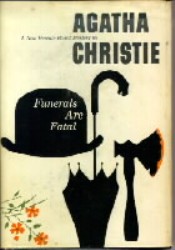
After the Funeral was first published in the US in March 1953 under the title of Funerals are Fatal.

